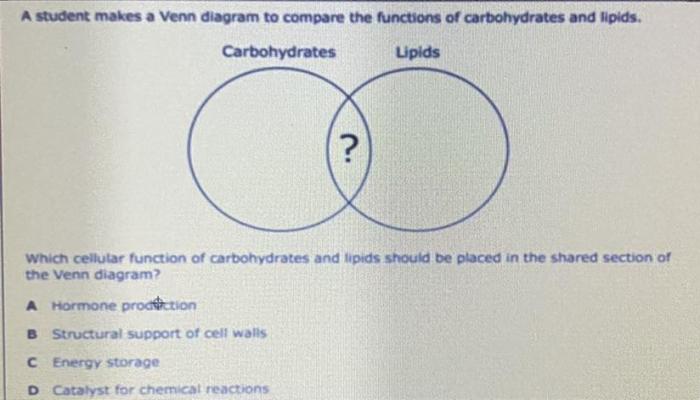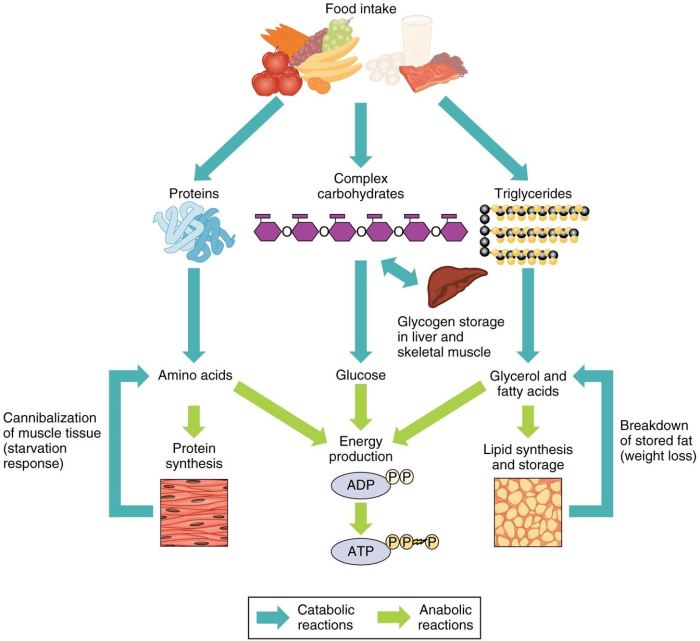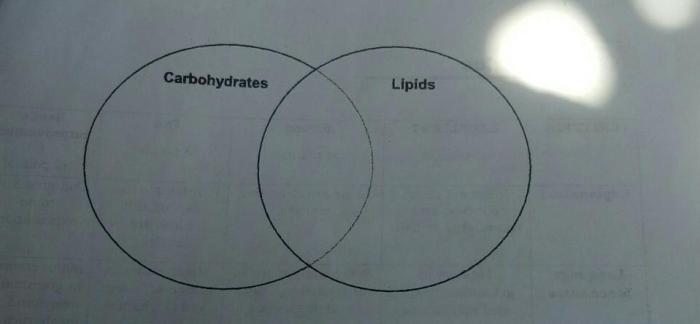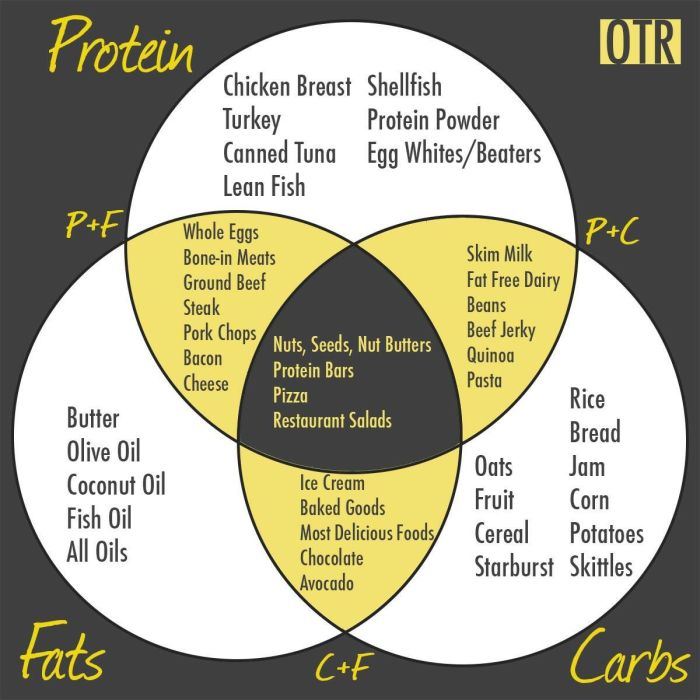The carbohydrates and lipids venn diagram unveils a captivating narrative that delves into the intricate world of these essential biomolecules. It illuminates their chemical structures, biological roles, and the profound implications they have on our health and well-being.
This comprehensive analysis explores the similarities and differences between carbohydrates and lipids, unraveling their distinct chemical compositions, structures, and functions. It sheds light on how these variations influence their properties and biological roles, providing a deeper understanding of their significance in living organisms.
Types of Carbohydrates and Lipids

Carbohydrates and lipids are two essential classes of biological molecules with distinct chemical structures and properties. Carbohydrates are composed of carbon, hydrogen, and oxygen, while lipids are composed of carbon, hydrogen, and oxygen, along with additional elements such as phosphorus, nitrogen, or sulfur.
Types of Carbohydrates
Carbohydrates can be classified into three main types: monosaccharides, disaccharides, and polysaccharides.
- Monosaccharidesare the simplest carbohydrates and consist of a single sugar unit. Examples include glucose, fructose, and galactose.
- Disaccharidesare formed by the covalent bonding of two monosaccharides. Examples include sucrose, lactose, and maltose.
- Polysaccharidesare complex carbohydrates composed of multiple monosaccharides linked together. Examples include starch, glycogen, and cellulose.
Types of Lipids
Lipids are a diverse group of molecules with varying structures and functions. The main types of lipids include:
- Fatty acidsare long-chain carboxylic acids. They can be saturated (no double bonds) or unsaturated (one or more double bonds).
- Triacylglycerolsare composed of three fatty acids esterified to a glycerol molecule. They are the main form of fat storage in animals and plants.
- Phospholipidsare lipids that contain a phosphate group. They are a major component of cell membranes.
- Steroidsare lipids with a four-ring structure. They include cholesterol, which is essential for cell membrane structure, and hormones such as estrogen and testosterone.
Similarities and Differences between Carbohydrates and Lipids

Carbohydrates and lipids are two essential classes of biological molecules that play vital roles in living organisms. They share some similarities in their chemical composition, but they also exhibit significant differences in their structure, function, and properties.
Chemical Composition
Both carbohydrates and lipids are composed of carbon, hydrogen, and oxygen. However, carbohydrates also contain nitrogen, while lipids do not. Carbohydrates have a ratio of hydrogen to oxygen of 2:1, while lipids have a ratio of 1:2.
Structure
Carbohydrates are composed of monosaccharides, which are simple sugars, or polysaccharides, which are polymers of monosaccharides. Lipids are composed of fatty acids, which are long hydrocarbon chains, and glycerol, which is a three-carbon alcohol. Fatty acids can be saturated, meaning they have no double bonds between their carbon atoms, or unsaturated, meaning they have one or more double bonds.
Function
Carbohydrates are the primary source of energy for living organisms. They are broken down into glucose, which is used by cells for energy production. Lipids are used for energy storage and insulation. They are also used as structural components of cell membranes and hormones.
Biological Roles of Carbohydrates and Lipids

Carbohydrates and lipids play essential biological roles in organisms. Carbohydrates primarily serve as an energy source, while lipids perform diverse functions, including structural components, energy storage, and signaling molecules.
Carbohydrates: Energy Source
Carbohydrates are the body’s primary source of energy. Glucose, a simple sugar, is the most important carbohydrate for energy metabolism. When glucose is broken down through cellular respiration, it releases energy in the form of ATP (adenosine triphosphate), the energy currency of cells.
Lipids: Structural Components and Energy Storage
Lipids have various structural roles in organisms. Phospholipids and cholesterol are essential components of cell membranes, providing a barrier and regulating membrane fluidity. Lipids also serve as energy storage molecules. Triglycerides, composed of three fatty acids attached to a glycerol backbone, are the main form of energy storage in animals and plants.
Metabolism of Carbohydrates and Lipids

Carbohydrates and lipids are the two primary energy sources for living organisms. Their metabolism involves a series of biochemical reactions that convert these molecules into energy.
Carbohydrate Metabolism
Carbohydrate metabolism begins with the breakdown of complex carbohydrates into simpler sugars, such as glucose. Glucose is then transported into cells, where it undergoes glycolysis, a series of reactions that convert glucose into pyruvate. Pyruvate can then be converted into acetyl-CoA, which enters the citric acid cycle, a series of reactions that generate ATP, the energy currency of cells.
Lipid Metabolism
Lipid metabolism begins with the breakdown of triglycerides into fatty acids and glycerol. Fatty acids are then transported into cells, where they undergo beta-oxidation, a series of reactions that convert fatty acids into acetyl-CoA. Acetyl-CoA can then enter the citric acid cycle, generating ATP.
Regulation of Metabolism, Carbohydrates and lipids venn diagram
The metabolism of carbohydrates and lipids is tightly regulated to ensure that the body has a constant supply of energy. This regulation involves a variety of hormones, including insulin and glucagon. Insulin promotes the uptake of glucose into cells and the storage of glucose as glycogen.
Glucagon promotes the breakdown of glycogen into glucose and the release of glucose into the bloodstream.
Contribution to Energy Production and Storage
Carbohydrates and lipids are both essential for energy production and storage. Carbohydrates provide a quick source of energy, while lipids provide a more sustained source of energy. The body stores carbohydrates as glycogen and lipids as triglycerides. When the body needs energy, it can break down glycogen and triglycerides into glucose and fatty acids, respectively, which can then be used to generate ATP.
Health Implications of Carbohydrates and Lipids
Carbohydrates and lipids are essential macronutrients for human health, but excessive or insufficient intake of these nutrients can have significant health implications.
Excessive consumption of refined carbohydrates, such as white bread, pasta, and sugary drinks, can lead to weight gain, insulin resistance, and type 2 diabetes. Conversely, insufficient intake of complex carbohydrates, such as whole grains, fruits, and vegetables, can result in fatigue, constipation, and impaired immune function.
Excessive Lipid Intake
- Increased risk of cardiovascular disease, including heart attack and stroke
- Weight gain and obesity
- High cholesterol levels
- Fatty liver disease
Insufficient Lipid Intake
- Impaired brain function
- Dry skin and hair
- Weakened immune system
- Hormonal imbalances
Essential Questionnaire: Carbohydrates And Lipids Venn Diagram
What are the primary functions of carbohydrates?
Carbohydrates serve as the primary source of energy for living organisms, providing the fuel necessary for cellular processes and activities.
How do lipids differ from carbohydrates in terms of their structure?
Lipids are composed of long chains of fatty acids, while carbohydrates are composed of sugars. This difference in structure contributes to their distinct properties and functions.
What is the significance of the venn diagram in understanding carbohydrates and lipids?
The venn diagram provides a visual representation of the similarities and differences between carbohydrates and lipids, highlighting their overlapping and unique characteristics.